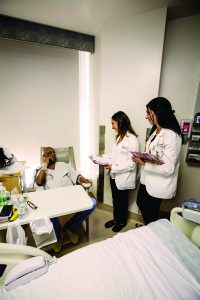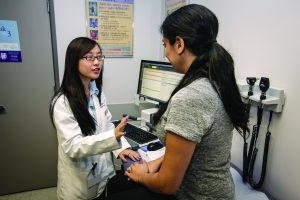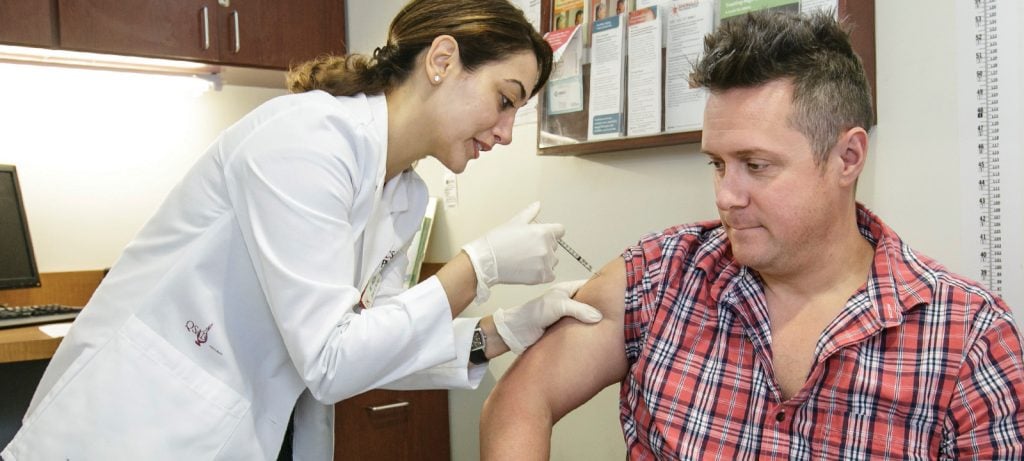The deepest understanding of any pursuit comes from hands-on learning. That includes becoming a pharmacist. The USC School of Pharmacy equips its students with the finest pharmacy education, including opportunities for in-depth patient interaction and real-world, on-the-job experience through a variety of experiential learning rotations.
In addition to several sites at USC — including five pharmacies operated by the School, Keck Medicine locations and the School’s Medication Management Center — hundreds of distinguished partners offer rotations that allow pharmacy students to hone their stills and engage with Southern California’s diverse patient population.
Students complete a slate of Introductory Pharmacy Practice Experiences (IPPEs) during their first three years in the program, and Advanced Pharmacy Practice Experiences (APPEs) during their fourth year. Expert preceptors — many of them School of Pharmacy alumni — guide USC PharmD students through rotations that reflect all of the challenging and rewarding aspects of the profession they will join after graduation.
The following highlights just three examples of the School’s dedicated experiential learning partners, representing inpatient, outpatient and community pharmacy settings.
Inpatient Care Rotation: Cedars-Sinai
At Cedars-Sinai, the largest freestanding, independent, nonprofit medical center in the Western United States, pharmacy students interact with attending physicians, pharmacists, case managers, nurses, fellows, residents and medical students.
“Every student should have the opportunity for patient education … Usually that involves discharge counseling of patients’ medications when they go home.”
Student rotations offered at Cedars-Sinai include acute care/medicine, infectious diseases, critical care, transplantation medicine and transitions of care, which ensures medication accuracy throughout the entire inpatient experience, from admission to discharge. Students review prior-to-admission medication lists to find inaccuracies; in addition to talking with patients and their families, the process often involves communication with physicians’ offices, transferring facilities and pharmacies. The students then continue to monitor and reconcile medications at every level of care within the medical center, as well as after discharge.
“Every student should have the opportunity for patient education,” says Tram Cat, PharmD, education coordinator at the Cedars-Sinai Department of Pharmacy Services. “Usually that involves discharge counseling of patients’ medications when they go home.”
“I’ve always encouraged students to be involved in taking histories, including allergy histories, and teaching patients about their anticoagulants, but we are trying to increase that interaction — especially for patients who need to take drugs when they go home,” says Chief Pharmacy Officer Rita Shane, PharmD ’78.
“I feel like every patient is unique and helps us see how much we’ve learned at school, and how it really does make a difference,” says PharmD student Sanam Roufeh, who recently completed a Cedars-Sinai rotation.

Roufeh was pleased to find that her suggestions were heeded by doctors, nurses and patients. “For example, I had a patient who could have benefited highly from a statin therapy but left the hospital without one,” she recalls. “We recommended it, and they implemented it.” “It’s rewarding to see the recommendations being taken and see how we’re making a meaningful impact on patients’ lives to help optimize the best medication regimen,” adds PharmD student Rachel Banafsheh.
Like the USC School of Pharmacy, Cedars-Sinai was a pioneer in embracing the pharmacist’s crucial role in the healthcare team — years before Senate Bill 493 recognized that fact in legislation.
“Pharmacists have long had the opportunity to practice at the highest level of their license in our organization, simply because they’ve been able to work with our medical staff to get approval for dosing under protocol and be supported in medication management in many, many ways,” says Shane.
That support extends to students on rotations at the medical center.
“By the end of the rotation, my goal is to have students be confident in what they’re doing and have excellent clinical skills to provide the best recommendations for the patients so they can optimize their regimen and feel confident to provide their recommendations to physicians,” says Olga Zaitseva, PharmD, a clinical pharmacist in transitions of care at Cedars-Sinai.
“It’s a privilege to watch them grow and become better healthcare practitioners,” adds Zaitseva. “They have a chance to apply all the knowledge that they learn in the classroom to real life and treat real patients. And my patients have expressed gratitude to the students when they realize how much they have learned from them.”
[iframe src=”https://player.vimeo.com/video/148684638″ width=”900″ height=”500″]
Ambulatory Care Rotaion: Kaiser Permanente
Kaiser Permanente offers pharmacy rotations in outpatient care, including asthma, acute care, pediatrics, anticoagulation, cardiology, nephrology, pain management and pediatric oncology, at several Southern California locations. Students can also choose rotations in administration to gain business and management experience, in inpatient and critical care and in nine different pharmacies.
Scott Takahashi, PharmD ’89, a Kaiser Permanente pediatric ambulatory care pharmacist, emphasizes with students the importance of communication. “They become versed in how to communicate with patients from different cultures — from the Spanish-speaking population of East Los Angeles to the people from Korea and the Middle East who reside in Glendale,” he says.
Being in a rotation teaches skills you can’t learn in a classroom.
Takahashi, who has mentored students as a preceptor for 25 years, believes that the ability to counsel and interview patients is crucial to being an effective pharmacist. While counseling is about ensuring that patients understand their medications and take them properly, interviewing is about the pharmacist understanding the patient’s circumstances, notes Takahashi. This helps pharmacists speak in ways that let the patient understand why the medication is important to their health. “It’s all about medication therapy management,” he says.
PharmD student Lily Feng was rotating through the anticoagulant service and congestive heart failure clinic when she learned that not all healthcare providers understand the importance of the pharmacist’s medication therapy management (MTM) role. She discovered that a patient had been discharged from another hospital with no instructions about the proper use of the medicines prescribed.

“I took that as a chance to explain and educate them,” she says. She ensured that the patient knew how to take the prescription properly.
Kaiser primarily welcomes fourth-year USC students to rotations, but also accepts some second- and third year students. Takahashi has advice for first-year students: “Get an intern job and work the hours,” he says. “It’s hard to work every weekend, but it’s really worth it in terms of what you gain, and in terms of how easy it is to get through classes. And when you come into rotation you’re going to be prepared to work with your preceptors side by side.”
With so many rotations available, Feng believes students should explore areas in which they are less knowledgeable “so you can learn it before you graduate.” She adds, “Being in a rotation teaches skills you can’t learn in a classroom.”
Community Rotation: Ralphs Pharmacy
During the Ralphs community pharmacy rotation, School of Pharmacy students and residents enjoy extensive interaction with patients in a community setting. Students also consult with physicians’ offices, administer immunizations, provide health screenings and assist with Ralphs’ new travel health clinic.
PharmD student Anet Minassian has learned that community pharmacy settings are about much more than filling prescriptions and she is enjoying expanding her abilities. “I was giving flu shots and performing MTM, so I could employ all my drug-interaction knowledge.” And, she says, “I really like interacting with patients.”
“It’s one thing to sit in a classroom and learn the textbook cases. It’s another thing to actually have a patient come in and get to know them,” says Karin Kharloubian, PharmD ’15, a USC community pharmacy resident at Ralphs. “Now that I’ve finished my PharmD, I get to apply everything I’ve learned and put it all together.”
Dikran Parsekyan, PharmD ’00, chief pharmacist at Ralphs in Sherman Oaks, says that pharmacists’ responsibilities have come a long way in the 15 years since he earned his degree. “When I graduated, flu shots were relatively new in the pharmacy, and we started cholesterol screenings about 10 years ago,” he says. “We’ve seen a big transition in the mindset of pharmacists as well as patients. People now just expect more clinical services from the pharmacy.”
I’m learning how to resolve problems, how to work directly with patients — and my preceptors have been really helpful.
The entire pharmacy team at Ralphs helps prepare students for this spectrum of responsibilities. “We go through the whole gamut, from filling prescriptions, doing the clinical services and the business aspect. We show them about ordering and how to keep the inventory at a good level,” says Parsekyan.
Salpi Yaghoubian, PharmD, patient care coordinator for the Ralphs site in Sherman Oaks, says that students work alongside pharmacists from day one. “Anything that we as pharmacists are involved in, we try to integrate students and residents,” she says. “If I’m going to have a conversation with a patient about a disease state, I involve a student or resident. Students may not expect that from a community pharmacy rotation.” Minassian says her Ralphs rotation is a valuable experience with supportive mentors. “I’m learning how to resolve problems, how to work directly with patients — and my preceptors have been really helpful.”
[iframe src=”https://player.vimeo.com/video/142145926″ width=”900″ height=”500″]


